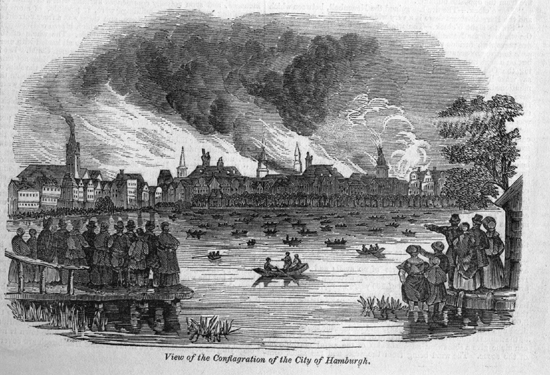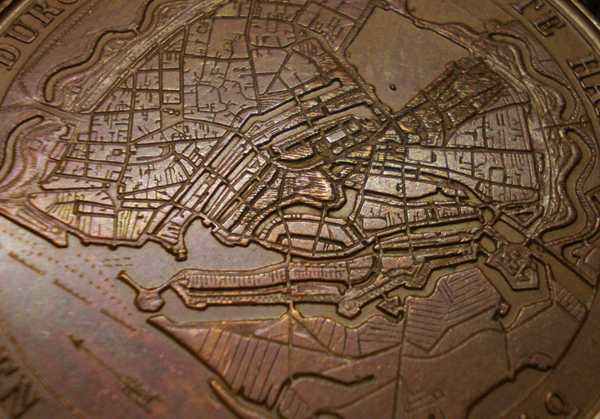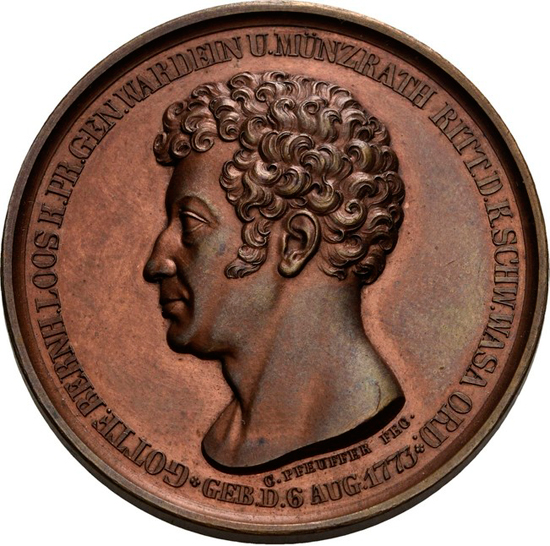
BRONZE MEDAL - HAMBURG GREAT FIRE OF 1842 COMMEMORATIVE
Hamburg
City of Hamburg Bronze Medal Commemorating the Great Fire of 1842 / Phoenix Rising and Detailed Map of City / From the Loos Medallic Establishment (Gaed. 2075)
This bronze medal was minted by the city of Hamburg, a sizable German city of commerce situated on the Elbe river. This medal was minted to commemorate the loss of about a quarter of the city in the "Great Fire" of 1842. This fire started on the night of May 4th, 1842, quickly spread through the heart of the city, and was finally extinguished on May 8. It destroyed three churches, the town hall, as well as many other buildings. It killed 51 people, and left an estimated 20,000 homeless. Reconstruction took more than 40 years.
This is a medal produced by the Loos Medallic Establishment under G Loos, a name that is probably very familiar to those who collect and study medals of the early to late 19th century. If you collect medals then there is a high likelihood you may have a medal in your collection that is signed G Loos alone (or some variation of this) or in combination with another name. If you collect or study coins and medals you may even have, or have seen, coins or medals that have the signature D. Loos, D.F. Loos, Dan Loos, F. Loos, FR Loos, L. or some variety of these initials. All of these signatures refer to various members of the prolific Loos Family, a family of men involved in the creation of coins and medals over generations during the 17th, 18th and 19th centuries. Although numerous members of this family produced coins and medals, by far the most common signature one might find from this family is G Loos which is the mark of Gottfried Bernhard Loos. Gottfried Bernhard Loos was born at Magdeburg into the business of coins and medals on August 6, 1773, the son of Daniel Friedrich Loos. Daniel Freidrich Loos (D or DF Loos) (Jan. 15 1735 - Oct 1, 1819) was a master engraver of coins and medals who studied under the Master Johann Friedrich Stieler and served as Mint Engraver and later Chief Engraver at Magdeburg from 1756 to 1767 and was medalist to the Prussian Royal Court at Berlin by 1768. In Berlin he set up shop in the upper water way near the Jungfernbrucke (the oldest bridge in Berlin) and promoted himself in a business directory with the verbiage "In this institution can be found among others in gold, silver and English Bronze pronounced a very considerable range of historical medals, occasion coins suitable as a gift...A printed directory of all viable varieties obtained in Comptoir." Here Daniel and his eldest son Friedrich Wilhelm Loos (F.Loos) (1742-1766) worked for a time producing medals and commemorative coins. Daniel served the Prussian government for 60 years, aided by his son for a time, he took on pupils to pass on the art and was an innovator and inventor of new mechanisms and techniques for the creation of medals and the striking of coins. The numismatist and author Heinrich Bolzenthal states that "In a time of bad tastes they applied themselves to the study of portraiture and ancient types." Other family members were the mint engraver and medalist Karl Friedrich Loos (L) who worked in Nuremberg between 1756 and 1770 and the mint engraver and medalist Georg Friedrich Loos who worked in Nuremberg between 1742 and 1766 and Würzburg between 1762 and 1766.
Both Gottfried and his elder brother Friedrich learned the family business. While Friedrich learned die cutting and engraving, passing away soon after the death of his father, Gottfried received a formal education and eventually gravitated towards the administrative side of the business learning all the facets of what it took to effectively run a minting operation. He began working at the Berlin mint in 1795 becoming Warden in 1797, he was appointed Mint Master and General Warden in 1812 and Mint Councilor in 1823. Shortly after he became the Mint Master at the Berlin Mint he expanded his father's company and founded the Loos Medallic Establishment, later the Berliner Medaillen-Münze (The Berlin Medal and Coin Establishment) in 1812. He hired artists and some of the best medalists of their time to produce a vast number of medals and commemorative coins for every occasion. During this time his company produced medals and coins for cities, towns, marriages, coronations, rifle clubs, exhibitions, organizations, and commemoratives of all types which he documented and offered in sales catalogs that he published and distributed. The output of his establishment was so vast that it would be nearly impossible to list every issue. Although Gottfried did not personally design or engrave the coins and medals his company produced, most of these issues bore his mark 'G Loos'. This has been seen by many as misleading as some may think, and many do, that this person whose name graces such a vast output is the highly prolific artist or craftsman who personally created these works. While Gottfried certainly retained creative control of the output of his company, he was first and foremost a businessman who was in the business of medals and coins. Although he put his own mark on his product, his company employed many artists and craftsmen who where often allowed to sign their works as well. Just like Walt Disney or Thomas Edison his job was not to create the product but to make it all possible. His efforts indeed made it possible to have a place to create, with all the tools to do so and he made it profitable so all would get paid for their efforts. Walt Disney worked with artists like Ub Iwerks and many, many others to produce cartoons and while he had the last word and creative control in what was released, he did not personally draw the frames or write the stories. His name was still placed on the finished product because he made it all possible to produce and distribute these cartoons, make them profitable and pay those creating them. Thomas Edison was an inventor himself but eventually he created a company and hired many engineers to innovate and create new technology to be produced and sold on the market. These engineers were paid for their work but their output was marketed under the Edison name. Just like these men and many others, Gottfried created an establishment wherein these artists could practice their craft and make a living by providing the significant infrastructure and materials needed to produce and sell these works at a profit. One might see his name on these medals as a trademark or brand for his company and not an attempt to take credit for the creative output of those who work with and for him. Gottfried grew up in his father's household, knew every aspect of the business and simply saw a way to improve it and make it more profitable. Gottfried Bernard Loos authored a book on detecting forgeries and was recognized for his contributions to the medallic arts before his death on July 29, 1843. His company continued on after his death, at first under the direction of his son Daniel Loos, also an engraver, who carried on the use of G Loos as the trademark name on the medals, and later under the direction of Ludwig Ostermann until 1879. |






